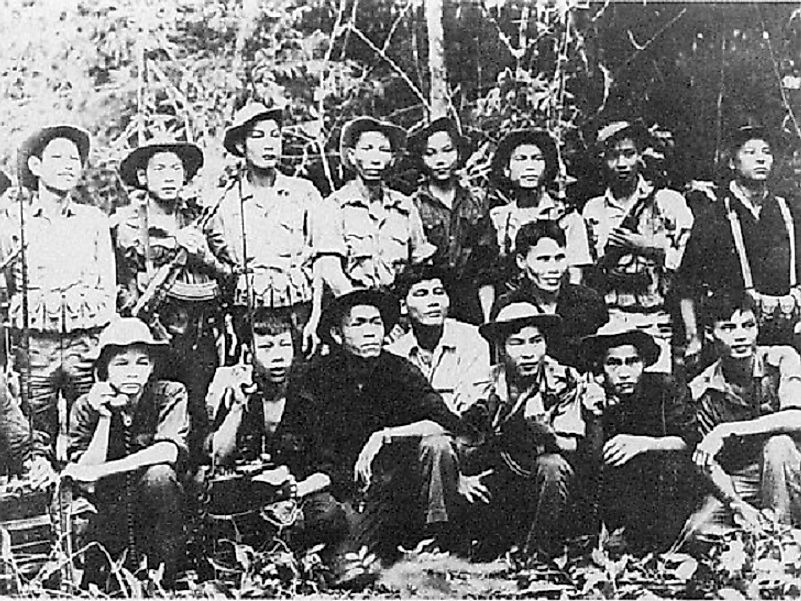The Tet Offensive - Vietnam War

5. Background
By 1967, the “attrition” strategies used by the United States were making the American public back home increasingly concerned. Public opinions were starting to sway the American public against the war, with 45% saying they were against the war by the second half of that year. To counter this negative perception, the American government launched "Success Offensive", a widespread propaganda campaign that aimed to alter the public perceptions of the war. Herein, Congress and the media were fed various (sometimes misleading) statistics that showed that the Americans were winning the war. Meanwhile, in North Vietnam, a military deadlock, along with the realization that they could not sustain the economic damage caused by the allied bombings, had ended the years-long political bickering between three factions within the Vietnamese Communist Party. A decision had been made to unite and focus on fighting their “true” enemies, and Hanoi was starting to make plans for a large-scale winter offensive to be implemented in the start of 1968.
4. Makeup
The communists were led by General Vo Nguyen Giap, of the People’s Army of Vietnam, and Hoàng Văn Thái, who was serving at the helm of the Viet Cong. The offensive called for a massive amount of logistical support and troops by both the attackers, and their U.S.-led targets who were supporting the South Vietnamese regime. By early January, there were roughly 320,000 combatants called up for the communists’ purposes in the campaign, including 160,000 Viet Cong, 130,000 North Vietnamese regulars, and 33,000 logistical and support troops. Most were equipped with AK-47 assault rifles and B-40 Rocket-Propelled- Grenade launchers. On the opposing side, U.S. Army General William Westmoreland led 78,013 Marines and 331,098 Army troops divided into 9 nine divisions. The South Vietnamese, led by General Cao Văn Viên, had 350,000 Army regulars, along with 151,000 South Vietnam Regional Force troops, and 149,000 South Vietnam Popular Force soldiers involved. Also with them were 2 army divisions and a marine brigade from South Korea, a royal regiment from the Thai army, the First Australian Task Force, and New Zealand military personnel.
3. Description
The offensive began on January 30th , on the eve of the Vietnamese New Year ("Tet"). Under the cover of a new year truce, the North started a major offensive and hit major cities all over South Vietnam. The North’s strategies began by first amassing rocket and mortar attacks upon their targets, followed shortly thereafter by human waves of ground troop attacks on army headquarters, radio stations, airfields. and other strategically important positions. The United States was unprepared for such a massive offensive. Lacking U.S. troop support across most of the contested region, the majority of the fighting was left to the South Vietnamese army and militants in the region.
The North encountered heavy resistance from the South. Contrary to General Giap's expectations, none of South Vietnamese army divisions broke or defected to the North. Within 2 to 3 days, the communists lost the majority of their occupied positions, with some being successfully taken by the South as early as a few hours after the fighting started. The North failed to break the South Vietnamese army and government. The massive uprising of the South Vietnamese people that they expected to happen from launching the offensive did not come to pass.
2. Outcome
Across all 3 phases of the Tet Offensive, which would span from January until September of 1968, the North Vietnamese and Viet Cong would report losing more than 45,000 of their soldiers’ lives, with even more than that wounded, and many captured. Figures for losses on the anti-communist side are conflicting, but most put the totals as being far lower than those suffered by the communists. Even more sadly, more than 14,000 civilians were killed in the crossfire, 24,000 were wounded, and hundreds of thousands of innocent people were misplaced or otherwise adversely affected by the campaign. By most accounts the attack was a failure, resulting in a tactical victory for the South Vietnamese forces, while the communists claimed a strategic and propaganda victory.
1. Significance
The Tet Offensive has a massive significance in the Vietnamese War. Though it failed to incite a massive peoples' uprising against the South Vietnamese government, it had a massive effect on the war-weary American public. Led to believe that they are winning the war, the news of a massive offensive from the North came as a massive shock. The offensive swayed the American public that the war is far from over, and was further worsened by the U.S. military leadership’s requests for additional Americans to fight. Tired and weary from the war and distrustful of the government, the people started demanding negotiations and a swift end to the war. The was the start of the United States' decision to negotiate with the Hanoi government, which would ultimately lead to the end of U.S. involvement in the war and the ultimate defeat of the South Vietnamese.











